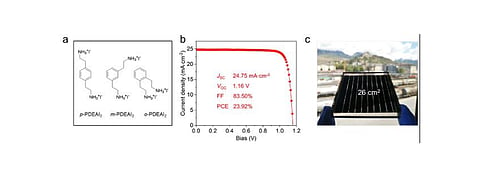

Using a 3D chemistry approach to better the manufacturing process of perovskite solar cells, a team of researchers led by Switzerland's École polytechnique fédérale de Lausanne (EPFL) has announced achieving a perovskite solar cell efficiency of 23.9%, on an active area of 26 cm².
They also claimed an operational stability beyond 1,000 hours along with a 'record efficiency' of 21.4% for perovskite modules.
The team achieved the feat by removing manufacturing defects for light-harvesting surface of lead iodide perovskites. For this, they treated the lead iodide perovskites with different isomers of an iodide used to make perovskites by arranging them in a 3-dimensional (3D) space.
For their research, the researchers studied the minimum energy required to form 2D perovskites for different isomers of the iodide PDEAI2 (phenylenediethylammonium), and designed isomers for 'tailored defect passivation'. Using this approach, they were able to avoid negative effects of passivation process on perovskite's efficiency.
It added, "Specifically, the most effective PDEAI2 isomer was also the most "sterically hindered", a term that refers to a slowing of chemical reactivity simply because of the compound's molecular bulk. In fact, steric hindrance is often used to prevent or minimize unwanted reactions."
According to the team, while passivation works best to make the cells more resistant and stable, it ends up forming an 'in-plane perovskite layers that do not move the electrical charge as well under heat. "This is an obvious disadvantage for scaling up and commercializing potential solar panels," stated the team.
Their work has been published in the scientific journal Nature Communications with the title Tuning structural isomers of phenylenediammonium to afford efficient and stable perovskite solar cells and modules.
In March 2021, the Massachusetts Institute of Technology reached 25.2% perovskite solar cell efficiency with the help of precise engineering technique for electron transport layer (see 25.2% Efficiency For Perovskite Solar Cell).
